L. Barraza and J. Pineda
Laura Barraza is a researcher at the Centro de Investigaciones en Ecosistemas, Universidad Nacional Autónoma de México (UNAM), Morelia, Michoacán, Mexico.
Jeannete Pineda recently completed her undergraduate studies at the same centre.
Results of a study assessing the knowledge of secondary school students about the forest and its problems, and the role of different educational systems in shaping their attitudes.
Secondary school students represent an important section of Results of a study assessing the knowledge of secondary school students about the forest and its problems, and the role of different educational systems in shaping their attitudes. Mexico’s population. Many of them, nearing the end of their formal education, will soon enter the world of work. Some will hold key decision-making positions. Knowledge about their perceptions and attitudes concerning forest resources may make it possible to provide the basic tools for developing an environmental ethic which will ultimately enhance the community.
This article presents the results of a study carried out to assess the knowledge of secondary school students concerning the forest and its problems. The study, carried out in two Mexican rural communities with contrasting forest management practices, examined the role of different educational systems in shaping young people’s attitudes.
As described here, the findings of the study indicate that, on the whole, the young people perceived forests as extraneous to them and were unaware of their biological, ecological and economic value. They were aware that forest destruction could affect them, but they were uncertain about how problems related to forest management could be resolved. The schools’ different teaching methods were found to have different effects on the young people’s knowledge and attitudes. Studies such as these could help to establish tangible methodological proposals for education and forest management programmes.
Mexico’s forests are a major source of natural resources, home to 10 percent of the world’s plant and animal species. However, demand for agricultural lands has resulted in the clearing of large forested areas. Loss of forest cover in Mexico is estimated at 631 000 ha per annum, equivalent to an annual deforestation rate of 1.1 percent (FAO, 2001).
The main factors responsible for deforestation in Mexico have been:
Forest conservation is under constant pressure because of the extension of the agricultural and livestock frontier, hunting, uncontrolled logging and the lack of community conservation strategies. Technology alone cannot solve these problems, since they arise partly from human attitudes towards the environment. Conservation requires fundamental changes in people’s ways of thinking and behaving. But people can learn to modify their attitudes about the environment only if the factors that influence those attitudes are understood (Barraza, 2001). These attitudes are usually linked to others, deeply embedded in the individual’s value system (Barraza, 1998). Culture plays a vital role in determining how people think, feel and act with regard to the environment. Hence the need for studies to examine people’s knowledge, beliefs and attitudes about ecosystems.
Environmental education promotes positive attitudes and is thus an important natural resource conservation tool. Yet education strategies require urgent changes and innovative approaches to meet changing needs. Schools are part of the process of change. They need to promote active interaction among children, teachers and parents. Education for the future must also be tackled in the classroom. It is necessary to examine people’s fears and expectations for the future so as to understand how these perceptions of the future influence the way people behave, and how their behaviour today will influence the future (Hicks and Holden, 1995).
Nuevo San Juan Parangaricutiro – where most of the economically active population participates both directly and indirectly in forestry activities |
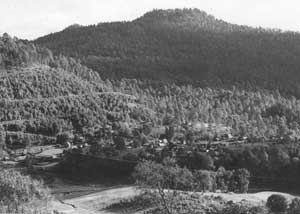 |
J. PINEDA |
Children playing in Atécuaro, where the main activities are forest use (32 percent), basic agriculture (25 percent) and grazing (14 percent) |
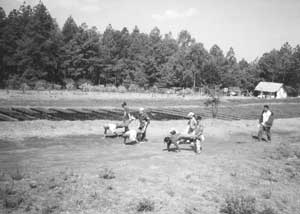 |
J. PINEDA |
The study was carried out in two rural communities, the Nuevo San Juan Parangaricutiro indigenous community (San Juan Nuevo) and the Atécuaro community, both located in Michoacán, the state with the highest rates of deforestation in Mexico (Masera, 1995). San Juan Nuevo, since 1988, has used a community forest management model involving forest protection, development and industry – a model which has attracted the attention of national and international organizations. Local nurseries collect seed of native trees for planting in degraded areas of sandy and unproductive land (Ordóñez, 1999). The community has obtained the full right to control and administer its forest resources. In 1991 it was granted title to communal assets, with 1 229 communal landowners (comuneros) recorded in a census. Since 1998, the community’s forests have been certified for sustainable forest management by the Forest Stewardship Council (FSC) (Fregoso, 2000). Most of the economically active population participates both directly and indirectly in forestry activities. Agricultural activities take second place. The main use of forest resources is the manufacture of products such as sawn timber, furniture and resin (Empresa Forestal de San Juan Nuevo, 1998).
The main activities of the Atécuaro community are forest use (not based on a management plan) (32 percent); basic agriculture (25 percent); and grazing (14 percent), which represents a change in land use involving extensive stock raising and temporary migration (Cabrera González, 2000). Other activities, such as fish-farming, are carried out on a smaller scale. About 15 percent of the area is eroded and 13 percent covered by shrub vegetation, connected with forest loss (Mas Porras, 1997). The amount of timber logged cannot be quantified because of illicit activity (Amador, 1997). The main uses of the forest are the production of timber and fuelwood for the community’s domestic uses. The shortage of economic resources and organizational problems have resulted in the uncontrolled and unmanaged use of forest resources.
The federal secondary school in San Juan Nuevo, which uses a traditional curriculum |
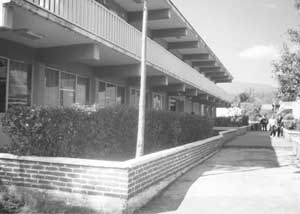 |
J. PINEDA |
The “telesecondary”school in Atécuaro, which uses a television-supported curriculum |
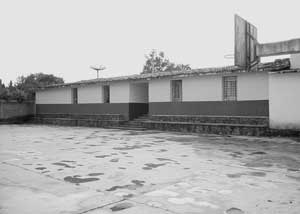 |
J. PINEDA |
The study focused on one rural secondary school in each of the two communities. The two schools employed different educational programmes: the federal school in San Juan Nuevo used a traditional curriculum, while the school in Atécuaro used a television-supported programme referred to as “telesecondary” education (telesecundaria) (Table 1).
A stratified random sampling system was used to obtain a sample of 108 young people – 70 from San Juan Nuevo and 38 from Atécuaro – from a total of about 500 students. The young people in the sample were in three different secondary years, aged 12 to 16 years (Table 2).
The study used multiple methods and both qualitative and quantitative tools, which made it possible to view the study subjects from various analytical perspectives (Robottom and Hart, 1993; Barraza, 1999, 2001). Three analytical variables were compared:
Teaching methods and facilities were evaluated through systematic observations which covered, for example, activities during class time, teaching materials, students’ behaviour in class and subject content. Subjects included physics, chemistry, biology and natural science (an introduction to physics and chemistry).
The young people’s attitudes about the forest were assessed using a questionnaire based on the Likert scale (a well-known tool for measuring attitudinal patterns) with 12 items and five levels of response. The questionnaire also included open questions to help assess the young people’s attitudes and knowledge. Responses to each question were divided into thematic categories based on content analysis. These questionnaires were also used with parents and natural sciences teachers and with persons making direct use of forest resources. Photographs were also used to assess perceptions. The respondents were asked to arrange photographs showing various degrees of degradation as an indicator of their perceptions of their community’s forest.
To determine significant differences between the variables, a non-parametric statistical analysis was carried out. The test used was c², and a significance level of 0.05 was obtained.
|
|||
| Year |
San Juan Nuevo | Atécuaro |
|
First |
28 |
21 |
|
| Second |
23 |
9 |
|
| Third |
19 |
8 |
|
| Total | 70 |
38 |
|
Students were asked to arrange photographs showing various degrees of degradation as an indicator of their perceptions of their community’s forest |
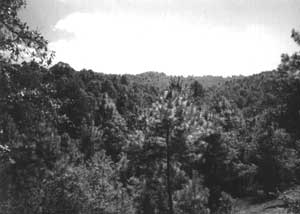 |
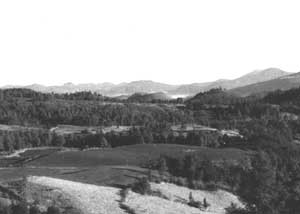 |
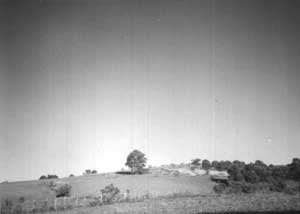 |
With regard to the perception assessment, the findings show that students in both communities were aware of a negative change in the state of their community forest. They thought that it had been seriously damaged, had fewer trees and animals and was more polluted, and they expected it to continue to deteriorate in the future. The findings also show that 80 percent of the group from San Juan Nuevo were aware of negative change, compared to 58 percent from Atécuaro. The others in the samples had either not observed any change or said that the forest was currently better cared for and that conditions could improve with reforestation and support from citizens.
The most significant differences were between the first year students of the two schools (see Figure 1). There were no significant differences between the children of the comuneros and the other students from the federal secondary school in San Juan Nuevo.
A little more than half the young people from San Juan Nuevo thought that their community forest was well cared for but had been better kept in the past. More than 60 percent of the students from Atécuaro thought that their community forest was well cared for. Less than 10 percent replied “don’t know” and 30 percent thought the forest had been damaged. In both communities the perception was that the forest would continue to decline. Most of the young people were aware that when forested areas disappear, biodiversity and recreational areas are lost and the climate also changes. A little over one-third of the young people of both communities were aware that species were disappearing. Forty-three and 31 percent of San Juan Nuevo and Atécuaro students, respectively, associated forest loss with loss of oxygen.
According to Grob (1995), environmental awareness is made up of knowledge of the environment and recognition of its problems. The students of both schools perceived few environmental problems and saw them as isolated events. They did not seem to understand the complexity of the ecosystem. The lack of trees was perceived as a problem, but was not perceived as the result of felling. The perception of the comuneros’ children in the federal school was the same as that of the other young people. The photograph exercise highlighted the young people’s lack of knowledge on forestry-related matters.
Very few of the young people in the study managed to identify any environmental consequences. When asked how the destruction of the forest would affect them personally, their answers were vague. The young people of both communities knew very little about the benefits of the forest and the consequences of their destruction.
The adolescents were asked to give a written answer about their understanding of the following forest-related concepts:
The findings show that the young people of both communities had very little knowledge of these concepts (Figure 2). The group from San Juan Nuevo was even less aware of these concepts than the Atécuaro group despite the former community’s integrated management policies; 20 percent understood the concepts of forest resources, erosion and loss of biodiversity and less than 35 percent knew what deforestation was.
Answers to the question, “A forest is…?” were grouped into four categories based on content analysis:
Thirty-four percent and 22 percent of young people in Atécuaro and San Juan Nuevo, respectively, described the forest from a biological perspective, i.e. as a place with many trees and animals (Figure 3). Twenty-eight percent of the students from Atécuaro thought that the forest was a place in need of protection (this opinion was more widespread among second-year students). Only 8 percent of the San Juan Nuevo students, all in the first year, shared that opinion. The forest was described by 62 percent of the Atécuaro students (mainly third-year) as a place that provided benefits. The others described the forest as a scenic place.
The perception of the children of the San Juan Nuevo comuneros working in forestry differed from that of the other young people. The comuneros’ children were more likely to describe the forest as a biological system from which benefits are obtained, whereas the other children from the same community described it merely as a scenic place. However, 12 percent of the students from this community thought that the forest benefited only the animals and plants that live in it. Forty percent thought that the beneficiaries were those who worked in the forest, 23 percent were unaware of the benefits and 26 percent thought that oxygen was the main advantage obtained from the forest. The Atécuaro students’ views regarding the benefits of the forest were very similar: 36 percent thought that the beneficiaries were those who worked in the forest, while 30 percent said that the forest provided benefits but were unable to identify those benefits.
The young people of both communities did not know there were laws to protect the forest. They confused laws with notices, such as “Do not litter” and “Prevent forest fires”. Many from San Juan Nuevo thought that the same laws protected the forest and the community.
Forty and 54 percent of the San Juan Nuevo and Atécuaro students, respectively, knew that tree felling and the sale of timber and resin were major forest activities. In Atécuaro, students were aware of the pillaging of land and wood.
Descriptions of causes and solutions are an expression of individuals’ level of awareness (Esteva and Reyes, 1998). The students were asked an open question about the main causes of forest degradation. The San Juan Nuevo students identified excessive felling, forest fires, brick manufacturing and inadequate forest management. In the Atécuaro community, excessive felling was thought to be the main cause. Technical and management solutions were seen to be needed for forest rehabilitation.
Forty-six percent of the San Juan Nuevo group thought that conservation activities such as tree planting, tree pruning and fire prevention campaigns were normal activities of forest enterprises. However, 12 percent of first-year students were unaware of the activities in which forest enterprises are involved. In Atécuaro, 62 percent thought that conservation activities such as reforestation were conducted by their community.
The findings of the Likert scaling indicated that the young people had a positive attitude about the different aspects of the forest. Overall, the attitude towards the forest of more than 75 percent of the young people of both communities was rated very positive, and that of the others was positive. None of those surveyed had a negative attitude.
In both communities, the following statements received the lowest scores on the Likert scale.
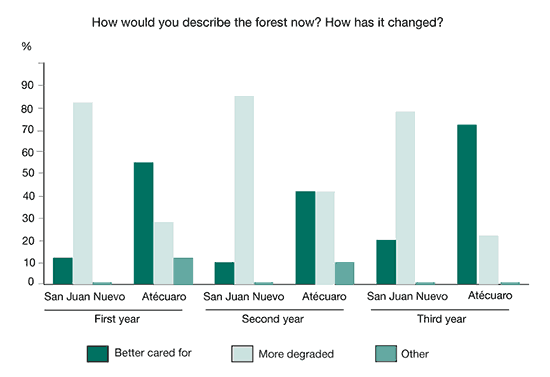 |
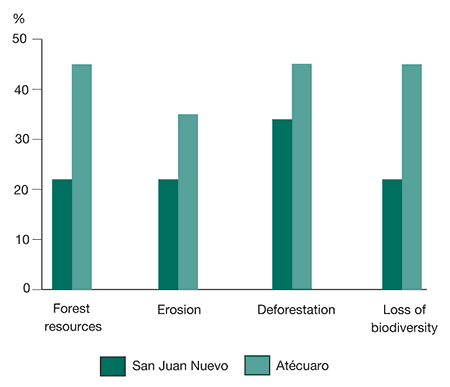 |
3 |
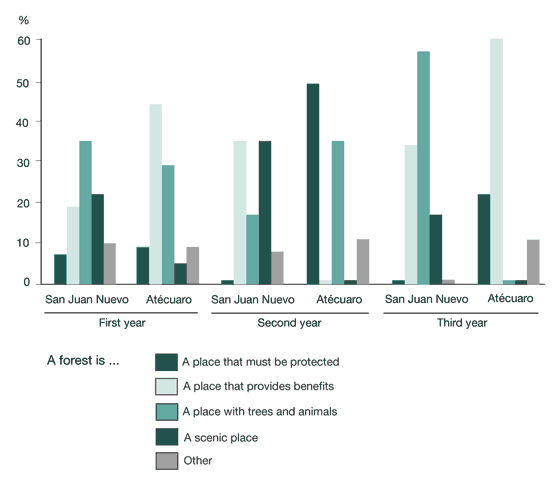 |
According to Fishbein’s theory of reasoned action (1967), there is a causal link between beliefs and behaviour: beliefs develop attitudes which in turn lead to intentions, and the intentions determine the behaviour (Figure 4).
The young people’s answers suggested that they were interested in what was happening to the forest; they were aware that forests provided benefits and had to be protected, that forest destruction affected them and that programmes and projects were needed to save forested areas. Their answers also revealed that the young people were interested in participating in forest protection and rehabilitation initiatives.
However, in most cases, what they were actually doing differed greatly from what they were thinking about doing. The young people’s participation in forest conservation and protection activities was poor. Fifty-six percent in Atécuaro and 50 percent in San Juan Nuevo said that they had not participated actively. Those who had participated were involved in reforestation. A smaller proportion had avoided leaving litter, and a very small number had helped to put out forest fires. It was surprising that although students in the third year of the telesecondary school in Atécuaro were managing a forest nursery as part of their schoolwork, their answers showed that they did not consider this to be an important forest rehabilitation activity.
To some degree the gap between the students’ intent and actions resulted from the fact that they were at an age of continuous development and change. However, the main reason for their inactivity was a lack of consistency between community development and formal education projects, which influenced the young people’s willingness to participate.
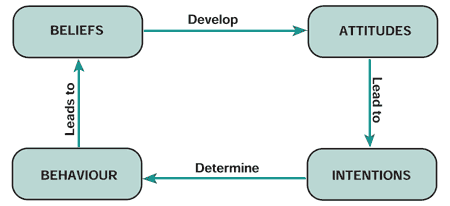 |
The study’s findings show that the education system influences young people’s knowledge and perception of the forest. All the students of both communities thought that it was important for their school to participate in forest protection. They said that schools should provide support by providing instruction and information on the forest. However, both community groups were passive in this recommendation. They were not able to identify practical activities that their schools could carry out.
The telesecondary teaching method has played a major role in the education of the young people of Atécuaro. The integrated approach links all subjects with the environment and environmental issues. On the other hand, the approach used in San Juan Nuevo gives the children a fragmented view of reality, as the subjects are not linked to forestry programmes and activities. What young people effectively learn about the environment is closely related to the schools’ teaching method and to the parents’ work in forest enterprises and in the community. (Barraza, 2003). While access to information is important, greater attention should be paid to how the information is transmitted and to parents’ role in this process in order to ensure that the information is understood and assimilated by the young people.
Many environmental problems remain unsolved partly because people fail to identify the problem clearly, are unaware of their own connection with it, or do not recognize to what extent the problem affects them or how to solve it (Wood and Walton, 1990).
The study described in this article revealed that the young people from two Mexican communities were not fully aware of the state of their communities’ forests. In general, they tended to be confused about the part they could play. They lacked knowledge about forest issues and about the consequences of the loss of their forests. They did not understand the extent to which their daily lives might be affected by forest issues and did not know how to deal with them. However, they recognized that some specific activities, such as excessive felling, forest fires and brick making, were the major causes of the problems. They recognized that forests provide benefits, but 26 percent thought oxygen was the only benefit from the forest. They knew that it was vital to conserve the forests and that forest loss affected them, and recognized that programmes and projects were needed to save forested areas.
Their perception of the forest was very limited. They were not able to identify biological, environmental or economic forest-related values. They did not see themselves as taking part in what was happening to the forest, and certainly
not as factors for change. However, they also said that they would like to participate in forest management programmes.
Proximity to forest management activities did not influence the perceptions, attitudes, sense of responsibility and knowledge of secondary-school students in either community directly. In Nuevo San Juan Parangaricutiro, the perceptions, attitudes and knowledge of the children of forest resource users were very similar to those of the other young people. The failure to encourage the link between forest users and schools has affected the transfer of information to the various sectors of the community. It is vital to adopt teaching methods based as much on the young people’s daily experiences as on current education theories (CESDER, 1998).
The teaching methods used in natural science subjects in the telesecondary school were seen to have a more positive influence on the young people’s knowledge of the environment than those used in the federal secondary school. Participation in community-based programmes is also essential to promote responsible behaviour.
For communities whose main profitable activity is forest use, several recommendations can be made for increasing awareness of forests. Communication programmes should be developed to provide information on forest-related projects. Environmental education programmes aimed at particular sectors of society should be promoted in formal and informal settings (schools, the forest, mass media). Teachers and community beneficiaries of forest resources should be actively involved in education projects. A link must be established between forest industries, communities and schools with a view to promoting a sense of responsibility for the environment in the population as a whole. Children and young people should be encouraged to participate in forest protection and conservation projects. To promote respect for the forest from school days onwards, school activities must be coordinated with community forest programmes.
Finally, studies on perceptions, attitudes and knowledge should be key components in the preparation of programmes for community education and forest resource management and conservation.
 Bibliography
Bibliography
Amador, G.A. 1997. Los recursos naturales de Atécuaro, Michoacán: uso actual y perspectivas de aprovechamiento. M.Sc. thesis, Universidad Michoacana de San Nicolás de Hidalgo, Michoacán, Mexico.
Barraza, L. 1998. Conservación y medio ambiente para niños menores de 5 años. Especies, (7)3: 19-23.
Barraza, L. 1999. Children’s drawings about the environment. Environmental Education Research, 5(1): 49-56.
Barraza, L. 2001. Perception of social and environmental problems by English and Mexican school children. Canadian Journal of Environmental Education, 6: 139-157.
Barraza, L. 2003. La formación de conceptos ambientales: el papel de los padres en la comunidad indígena de San Juan Nuevo Parangaricutiro. Gaceta, 66: 54-58.
Cabrera González, A. 2000. Desarrollo integral de la cuenca de Atécuaro. B.Sc. thesis. Universidad Michoacana de San Nicolás de Hidalgo, Michoacán, Mexico.
Centro de Estudios para el Desarrollo Rural (CESDER). 1998. Educación para el medio rural: una propuesta pedagógica. Monterrey, Mexico, Ed. Castillo.
Empresa Forestal de San Juan Nuevo. 1998. Plan rector. San Juan Nuevo Parangaricutiro, Mexico.
Esteva, P.J. & Reyes, R.J. 1998. Manual del promotor y educador ambiental para el desarrollo sustentable. Mexico City, Mexico, Editorial PNUMA.
FAO. 2001. Global Forest Resources Assessment 2000 – main report. FAO Forestry Paper No. 140. Rome.
Fishbein, M. 1967. Readings in attitude theory and measurement. New York, USA, John Wiley and Sons.
Fregoso, D.A. 2000. La vegetación, herramienta base para la planeación, aprovechamiento y conservación de los recursos forestales: el caso de la comunidad indígena de Nuevo San Juan Parangaricutiro, Mich., México. Thesis. Universidad Nacional Autónoma de México, Mexico City, Mexico.
Grob, A. 1995. A structural model of environmental attitudes and behaviour. Journal of Environmental Psychology, 15: 209-220.
Hicks, D. & Holden, C. 1995. Visions of the future: why we need to teach for tomorrow. London, Trentham Books.
Masera, R.O. 1995. Deforestación y degradación forestal en México. Mexico City, Mexico, Universidad Nacional Autonóma de México.
Mas Porras, J. 1997. Presupuesto para la elaboración del programa de manejo forestal de tipo persistente para los bosques del ejido de Atécuaro. Morelia, Mexico, Municipality of Morelia.
Ordóñez, D.J.A.B. 1999. Captura de carbono en un bosque templado, el caso de San Juan Nuevo, Michoacán. Mexico City, Mexico, Secretariat of Environment, Natural Resources and Fisheries (SEMARNAP).
Robottom, I. & Hart, P. 1993. Research in environmental education. Deakin, Australia, Deakin University Press.
Wood, S.D. & Walton, W.D. 1990. How to plan a conservation education program. Washington, DC, USA, Center for International Development and Environment of the World Resources Institute (WRI) and United States Fish and Wildlife Service (USFWS).